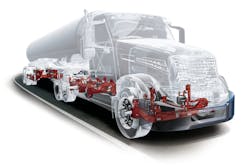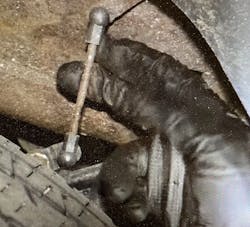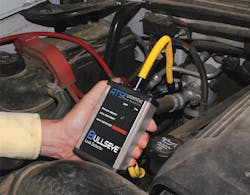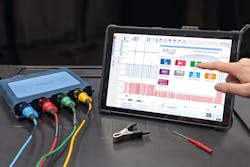A vehicle’s suspension system features springs and dampers (shocks). The spring supports vehicle weight and determines ride height. The dampers (shocks and struts) provide control of the springs, dampening compression and rebound.
Coil or leaf springs provide non-adjustable support. When overloaded with additional weight, the springs compress and, depending on the amount of weight (fore/aft or lateral), reduce ride height. Air suspensions utilize inflatable airbags, in addition to or in place of steel springs. The addition of rear “air shocks” allowed owners to compensate for rear weight by simply swapping out the original shock absorbers with shocks that incorporate built-in airbags (Figure 1).
Today, many vehicle manufacturers offer air suspension systems (either as standard or an option) that replace steel springs with strut-style air spring/damper units (pneumatic). These are controlled by an on-board air compressor and control modules, regulating ride height on demand (either by driver selection or automatically, depending on design). So when a vehicle owner loads the rear of a Dodge Ram or Chevy Suburban (for example), if the vehicle is equipped with air suspension, the ride height sensors detect the change in ride height (Figure 2); the control module commands the compressor to activate, providing additional inflation pressure to the air springs; and the rear ride height is restored to original specs.
System components
The air suspension compressor supplies the entire system with compressed air to inflate the air spring and is generally mounted on the vehicle’s frame or in the trunk. The compressor assembly consists of an electronic pump; a dryer filled with a desiccant to absorb moisture; mounting hardware, including rubber isolators and brackets; and thermal overload protection to help prevent the unit from overheating (burn-out) due to overuse.
Burn-out is normally caused by a small leak in one or more of the air springs, or less commonly, other components that cause the compressor to continually cycle in its effort to maintain the proper vehicle ride height. Signs of compressor failure include symptoms such as longer run-time, a louder noise when activated, or dashboard warning lights. They alert the driver and repair shop to trouble and signal that underlying issues will need to be fixed. Compressor warranties are often voided when burnout is indicated. Here are system components:
- Air lines: They carry compressed air to the air springs or air shocks. The lines are typically high-pressure air lines and are routed along the frame of the vehicle protected from heat and pinch points.
- Valve blocks: They allow air to enter the system. Valves isolate and control where air is directed and how. While valve blocks are rugged, air line fittings have rubber seals that might dry rot and fail, causing damage to the rest of the valve block.
- Solenoids: They are used in electronically controlled air suspension systems to fill and release air from each air spring.
- Control module: Electronic air suspension systems are managed through a control module. The controlling software can be very basic, offering not much more than an analog on/off switch, or it may be more sophisticated, monitoring pressure and ride height in real time.
Diagnosing and fixing air suspension problems
Many consumers miss the early warning signs of an air suspension issue. Unfortunately, these problems only get worse and more expensive over time. The main signs of air suspension problems include:
The dashboard warning light. One of the obvious signs of an air suspension problem is when a dashboard warning light comes on. Even if the light doesn’t stay on, the vehicle should be checked. Using a capable scan tool (with adequate software) should be enough to allow for proper initial analysis.
Suspension sagging. One of the first signs of an air suspension problem is when a car sags in a corner or entire side. Typically, this is due to the rubber air spring developing tiny cracks or holes because of dry rot or road debris. If a customer notes that their vehicle drops in height overnight or after they park, they most likely have leaks in their air spring or strut. Leaks can be easy to detect but can also be difficult. Utilizing a scan tool (for bidirectional control) to isolate portions of the system should allow you to focus on an area of the system where a leak is present. Using a soapy solution of water in a spray bottle will allow you to pinpoint the exact leak location. A popular approach to finding these tiny leaks is by using a combination of CO2 gas and a leak detection system, such as the BullsEye Leak Detector from Automotive Test Solutions (Figure 3).
Air suspension compressor constantly working. If there is damage to the air springs, the compressor will constantly be pumping air to keep the air bladders inflated. If the compressor is constantly running, the system should be examined as soon as possible. When compressors are overworked, they begin to overheat and eventually fail. Monitoring electrical current flow of the compressor motor (using a lab scope and amp probe) on known-good vehicles will allow you to become familiar with what a normal functioning pump’s operation should look like (Figure 4). Only then will you be able to efficiently use this strategy to recognize a failing pump’s signature, before symptoms are present, preventing come-backs. A DVOM can also work, however you will not have visible signature of the current, only the current value.
Compressor not working at all. The air suspension system cannot function without the compressor. If the compressor does not come on at all, that may be a sign that it was overworked and has burned out or it could be as simple as a fuse or relay problem. Of course, referencing a proper wiring diagram is where the analysis should always begin. Whether it’s sourced from Mitchell, MotoLogic, ALLDATA, Identifix, or even factory OEM information, it's crucial to an accurate diagnosis. We should always aim to find the root-cause of the failure, not just replace the failed component.
Compressor making noises. The owner may also notice abnormal noises during compressor operation, such as loud clicking, whining, or grinding. This could be a sign that the compressor has been overworked, or there could be excess moisture in the system because the compressor’s dryer is saturated. Once the compressor has been replaced the rest of the system, including the air springs and struts, should be tested.
Other suspension issues also might apply to air suspension, including:
- The vehicle bottoms out over bumps or rides rough
- It nose-dives when stopping
- The vehicle pulls to one side or steering is difficult
- The car continues to bounce after hitting a bump
- Uneven tire tread wear
- The shock portion of the strut appears to be oily or damaged
If the customer complains about any of these symptoms and if the vehicle is more than five years old or has more than 50,000 miles, you should inspect it for signs of air suspension damage. This can be conducted using electronic chassis ears, to help pinpoint noises. Obviously, the rest of the chassis and suspension components should be properly inspected. This includes verifying the correct tires for the vehicle are installed, adequate tire pressure, and the vehicle is within proper alignment specifications.
If the vehicles dashboard’s suspension warning light comes on, but the vehicle seems to be maintaining its height, you should use a scanner to diagnose the fault code. Typically, this is an electrical problem such as a relay, fuse, or skewed sensor data.
If the vehicle sags at one corner or side, the easiest way to diagnose the air suspension problem is to put the vehicle on a lift and do a visual inspection of the air struts and springs, the ride height sensors, air lines and connections and the compressor (Figure 5). To locate leaks in the air suspension system, spray the air bladders, fittings and lines and top seal, with the soapy solution, and watch for the bubbles (as described earlier).
The fix alternatives
There are multiple options for repairing and replacing a leaking air spring or strut. New OE springs, struts, and compressors are expensive at dealerships, but aftermarket vendors offer options that cost far less. Arnott, for example, offers new OE-quality compressors, as well as brand new replacement air springs that are often easier to install than the OE and built with heavier duty rubber. They also offer both new aftermarket replacement struts that they design and assemble and remanufactured OE struts.
While remanufactured struts maintain the vehicle’s electronic or active damping, as well as provide auto-leveling at a fraction of the price of a new OE strut, be aware that some suppliers may only repaint the external core parts and replace the leaking air bladder with a new one, leaving a shock and strut that has an unknown number of miles and problems.
Quality-minded suppliers will recharge the damper by replacing the old, worn oil that has gone through literally millions of cycles with new high-performance shock oil, while also replacing worn seals, wear bands, and top caps. They also computer test the damper and active damping coil to assure proper functionality and ride quality.
For older vehicles and those without active damping, new aftermarket struts are available that include a brand-new shock assembly with zero miles. Manufacturers like Arnott designed new struts that are built from the ground up with all new components, including a name brand air bladder, new strut body, isolators, bottom mount brackets, dust boots, mounting bolts, and top caps, many of which are machined by using aircraft quality aluminum. New struts are typically pre-assembled for easy installation, don’t require a core deposit or core processing, and provide a responsive, OE-like ride.
Eliminating issues: The budget fix
If a vehicle has multiple air suspension problems or has had a long history of issues, it might be more cost-effective to replace the air suspension with a coil conversion kit. Some kits cost about the same as a single air strut at a dealership, but should provide many years of trouble-free driving.
Granted, the “luxury” of having an air system that alters ride height as needs change, and simply converting from the air system in favor of coil-over replacements completely eliminates the potential problems that can be exhibited by a problematic — and often complex — and expensive air system.
The bottom line is air suspension repairs are not difficult to diagnose or fix. You should be inspecting the systems after 50,000 miles and customers should be encouraged to repair their air suspension problems quickly before one problem turns into multiple, more expensive, problems.
TOOLS USED:
-Steelman Electronic Chassis Ears
-PICO 4425a lab scope
-Low Amp Current Probe
-ATS Bullseye Leak Detector System
-Any capable scan tool (must have Enhanced OEM data/not generic)
-DVOMs
-Service information systems
-Alignment machine
-Tire pressure gauge
About the Author
Mike Mavrigian
Motor Age Editor
Mike Mavrigian has written thousands of automotive technical magazine articles involving a variety of specialties, from engine building to wheel alignment, and has authored more than a dozen books that crisscross the automotive spectrum. Mike operates Birchwood Automotive, an Ohio shop that builds custom engines and performs vintage vehicle restorations. The shop also features a professional photo studio to document projects and to create images for articles and books.






